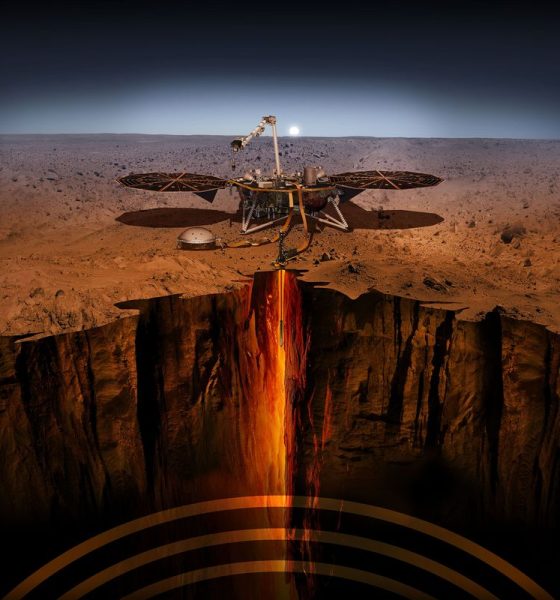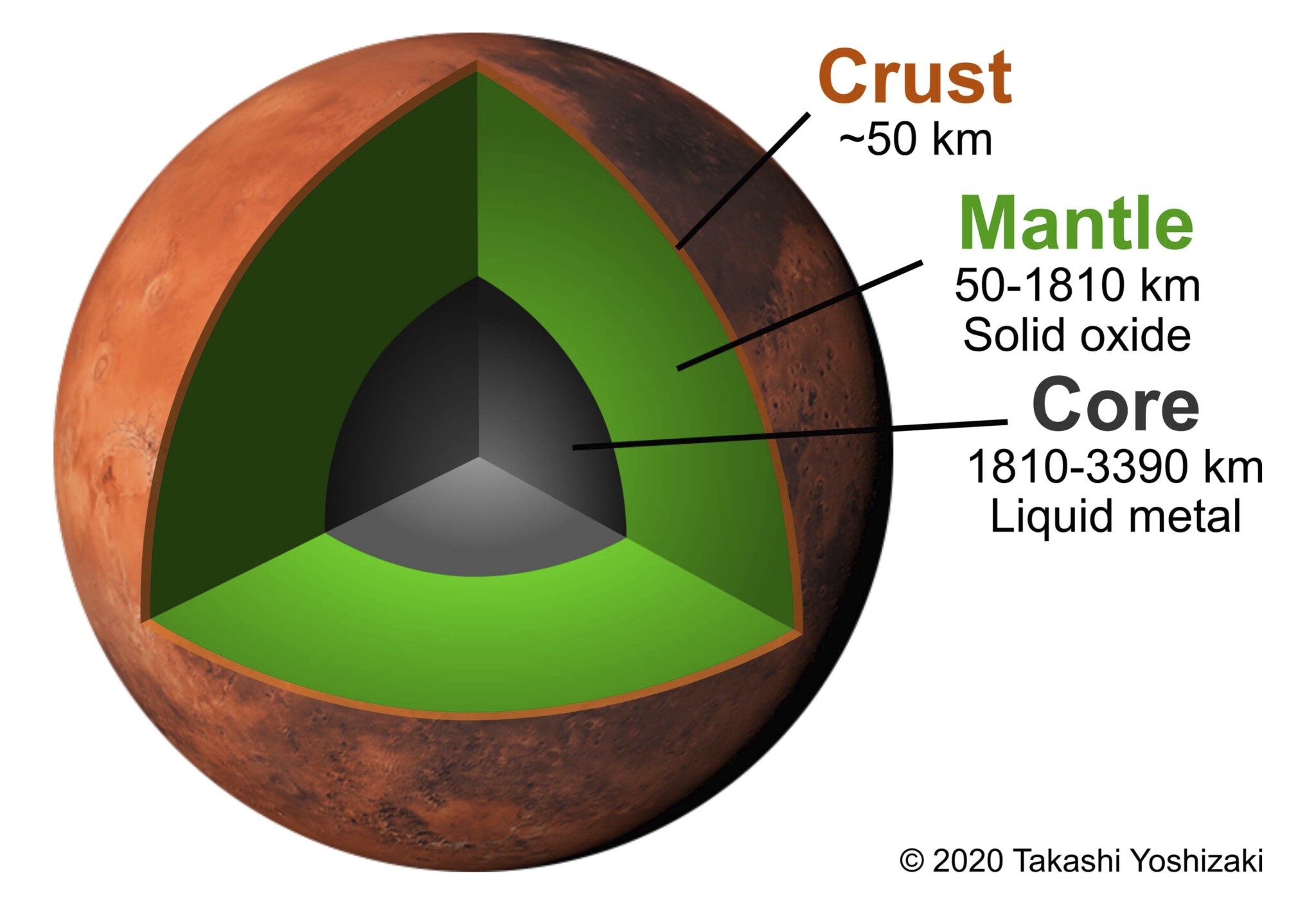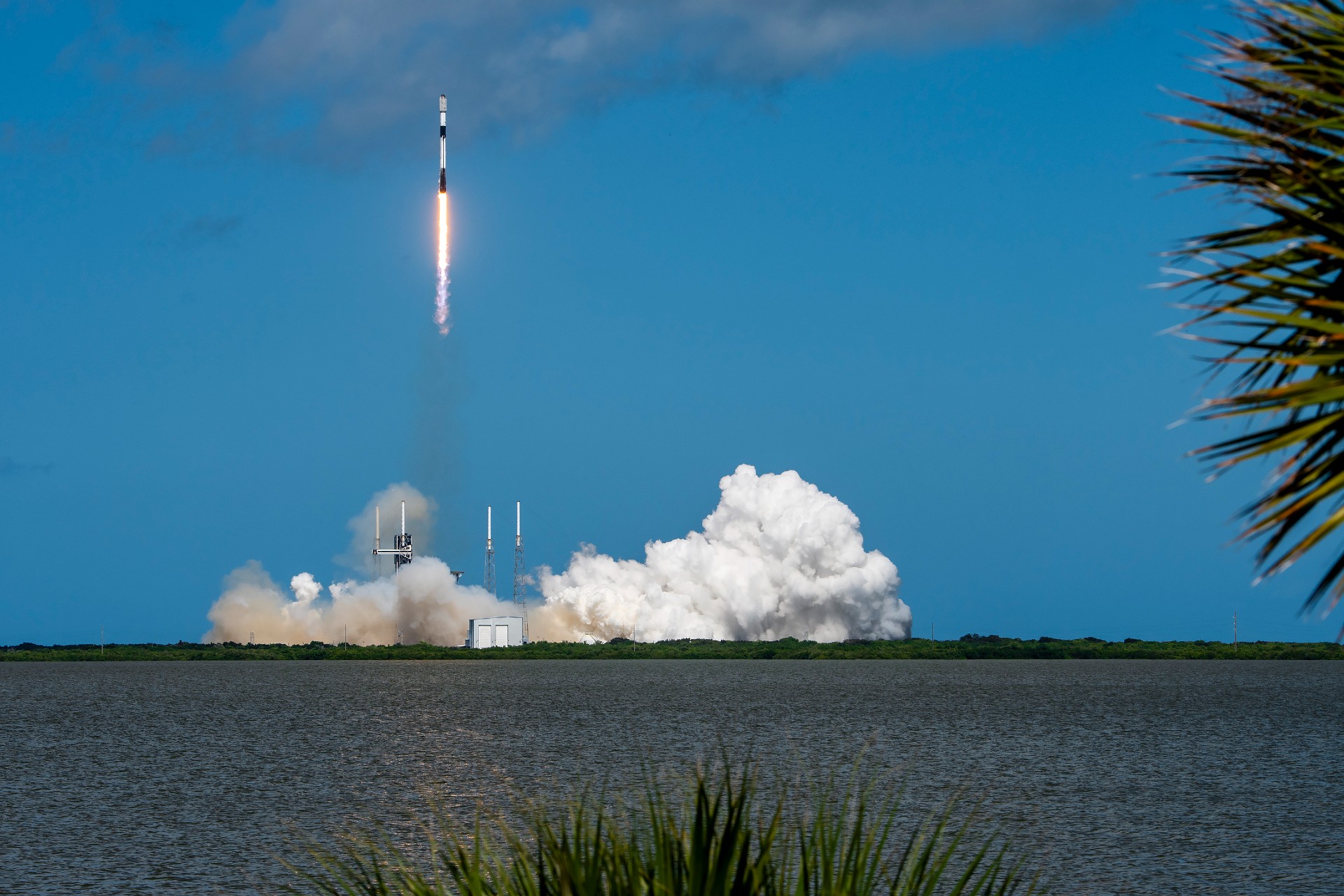

Space
‘Marsquakes’ are a thing and they can tell us a lot about the red planet
NASA’s InSight lander has spent the last year listening to the deep rumble of the red planet’s interior. And its first batch of data is in. The stationary lander found out that Mars’ magnetic field is constantly changing, but that’s not all. InSight also delivered the first direct evidence of marsquakes.
Here on Earth, geologists use seismometers to listen to the planet’s inner stirrings. InSight is the first robotic explorer to carry a seismometer to another planet. And it’s shown that Mars is not the dead, lifeless world it appears to be — the red planet is actually geologically active.
“This is the first mission focused on taking direct geophysical measurements of any planet besides Earth, and it’s given us our first real understanding of Mars’ interior structure and geological processes,” geologist Nicholas Schmerr of the University of Maryland said in a news release.
“These data are helping us understand how the planet works, its rate of seismicity, how active it is and where it’s active.”
InSight’s seismometer, an ultra-sensitive instrument provided by the French space agency, will shed some light on the red planet’s inner workings over the course of its mission. Officially dubbed the Seismic Experiment for Interior Structure, the SEIS instrument detected its first Martian rumblings last April.
Ever since, scientists were eager to get their hands on the full spectrum of data, to better understand just how active our celestial neighbor might be.
These first Martian murmurs were so faint, they’d probably go unnoticed by anyone on the surface. Roughly equivalent to about a 2 or 2.5 quake here on Earth, to InSight’s science team, these were incredibly exciting and just the beginning of a new era of Mars science.

Seismic waves can tell us a lot about a planetary body. They act like an ultrasound, allowing us to “peer” below the surface and determine the planet’s composition.
Here on Earth, seismic waves are caused by the movement of tectonic plates gliding over the planet’s mantle. When the plates jockey for position, stress builds up until it reaches a critical point, and that’s when an earthquake is triggered. But not every planetary body has these types of plates. The moon, for instance, has seismic activity that’s caused by a different method.
After a planetary body is formed, it has a primordial heat source that over time cools off. In the case of a rocky body, like the moon, that lacks any sort of tectonic plate movement, the seismic activity is caused by internal cooling. As the satellite cools, it ever so slightly shrinks, sending minute seismic waves propagating through its interior. The Apollo program recorded examples of this and InSight has now shown that Mars has similar activity.

Seismic data was collected over the course of 235 Martian days. 174 marsquakes were recorded during that time; 150 of those were shown to be similar to the Apollo program’s findings on the moon. Three of the other 24 produced wave patterns similar to quakes experienced here on Earth as a result of tectonic plate movement.
But as far as we know, Mars does not have tectonic plates. The science team was able to pinpoint the origin of three of the quakes: a fractured piece of land called Cerberus Fossae. Here the ground is cracked and fractured suggesting it was once tectonically or volcanically active. (Sometime within the last 10 million years, something pulled the ground apart here.)
Scientists are hoping that as more data comes in, they will be able to piece together what is causing Mars to tremble, and learn more about the red planet’s interior in the process.

Cybertruck
Tesla Cybertruck fleet takes over at SpaceX’s Starbase
Interestingly, the Cybertruck uses the same exterior, a stainless steel alloy, as SpaceX rockets. This synergy between the two companies and their very different products shows a very unified mentality between Musk companies.

Tesla Cybertrucks have taken over at SpaceX’s Starbase facility in Texas, as hundreds of the all-electric pickup trucks were spotted late last week rounding out a massive fleet of vehicles.
The Cybertruck fleet is geared toward replacing gas vehicles that are used at Starbase for everyday operations. The only surprise about this is that it was not done sooner:
Was just visiting. pic.twitter.com/5Q9wPPaeuH
— Derek Li (@derek1ee) October 31, 2025
Deliveries have been going on for a few weeks, as Cybertrucks have made their way across the state of Texas from Austin to Starbase so they could be included in SpaceX’s fleet of vehicles at the facility.
Interestingly, the Cybertruck uses the same exterior, a stainless steel alloy, as SpaceX rockets. This synergy between the two companies and their very different products shows a very unified mentality between Musk companies.
However, there are some other perspectives to consider as SpaceX is utilizing such a massive fleet of Cybertrucks. Some media outlets (unsurprisingly) are seeing this as a move of weakness by both Tesla and SpaceX, as the aerospace company is, in a sense, “bailing out” lagging sales for the all-electric pickup.
It’s no secret that Tesla has struggled with the Cybertruck this year, and deliveries have been underwhelming in the sense that the company was anticipating between 1 million and 2 million orders for the vehicle before it was widely produced.
A lot of things changed with the Cybertruck between its 2019 unveiling and 2023 initial deliveries, most notably, price.
The price of the Cybertruck swelled significantly and priced out many of those who had pre-ordered it. Some have weighed the option of whether this purchase was a way to get rid of sitting inventory.
However, it seems more logical to consider the fact that SpaceX was likely always going to transition to Teslas for its fleet, especially at Starship, at some point.
It doesn’t seem out of the question that one Musk company would utilize another Musk company’s products, especially considering the Cybertruck has been teased as the vehicle that would be present on Mars.
News
SpaceX opens up free Starlink service for those impacted by Hurricane Melissa

SpaceX is opening up its internet service, Starlink, to those impacted by Hurricane Melissa, as it made landfall in Jamaica and the Bahamas as a Category 5 storm.
Hurricane Melissa is expected to reach wind speeds of over 165 MPH over the next few days as it extends out into the Atlantic Ocean by Thursday and Friday.
Satellite imagery shows Hurricane #Melissa‘s growth from its formation on October 21 to a Category 5 hurricane through October 27, 2025. #HurricaneMelissa pic.twitter.com/goR3Hbgb9c
— The Weather Network (@weathernetwork) October 27, 2025
Citizens in Jamaica and the Bahamas have been preparing for the storm for the past week, getting necessary goods together and preparing for the massive storm to arrive. It finally did yesterday, and the first images and video of the storm are showing that it could destroy many parts of both countries.
Starlink is now being opened up for free until the end of November for those impacted by the storm in Jamaica and the Bahamas, SpaceX announced today:
For those impacted by Hurricane Melissa in Jamaica and the Bahamas, Starlink service is now free through the end of November to help with response and recovery efforts → https://t.co/fUko3xSviJ
— Starlink (@Starlink) October 28, 2025
It is a move similar to the one the company made last year as Hurricane Helene made its way through the United States, destroying homes and property across the East Coast. SpaceX offered free service for those impacted by the destruction caused by the storm.
The free Starlink service was available until the end of 2024.
Elon Musk’s companies have also made similar moves to help out those who are impacted by natural disasters. Tesla has offered Free Supercharging in the past, most notably during the California wildfires.
Tesla and SpaceX’s LA fire relief efforts: Cybertrucks, free Starlink and more
One major advantage of Starlink is that it is available for use in situations like this one, where power might be required to operate things like a modem and router.
Internet access is a crucial part of survival in these situations, especially as it can be the last leg some stand on to get in touch with emergency services or loved ones.
News
SpaceX reaches incredible Starlink milestone

SpaceX has reached an incredible milestone with its Starlink program, officially surpassing 10,000 satellites launched into low Earth orbit since starting the program back in 2019.
Last Sunday, October 19, SpaceX launched its 131st and 132nd Falcon 9 missions of 2025, one from Cape Canaveral, Florida, and the other from Vandenberg, California.
The 10,000th Starlink satellite was aboard the launch from California, which was Starlink 11-19, and held 28 v2 mini optimized satellites.
The achievement was marked by a satellite tracker developed by Jonathan McDowell.
🚨 With its Falcon 9 launch last Sunday, SpaceX officially has 10,000 Starlink satellites in orbit pic.twitter.com/xS5RVZ4ix0
— TESLARATI (@Teslarati) October 26, 2025
The first Starlink launch was all the way back on May 23, 2019, as SpaceX launched its first 60 satellites from Cape Canaveral using a Falcon 9 rocket.
Of the over 10,000 satellites in orbit, the tracker says 8,608 are operational, as some are intentionally de-orbited after becoming faulty and destroyed in the atmosphere.
SpaceX has truly done some really incredible things during its development of the Starlink program, including launch coverage in a global setting, bringing along millions of active subscribers that use the service for personal and business use, locking up commercial partnerships, and more.
Starlink currently operates in around 150 countries, territories, and markets and is available at least somewhere on all seven continents.
Additionally, Starlink has over 5 million subscribers worldwide, and 2.7 million have joined the program over the past year. It has revolutionized internet access on commercial aircraft as well, as several high-profile airlines like Qatar and United, among many others, have already installed Starlink on some of their planes to deliver more stable connectivity for passengers and crew.
SpaceX has the approval to launch 12,000 Starlink satellites from the FAA, but it plans to bring over 30,000 to its constellation, giving anyone the ability to have access to high-speed internet.








